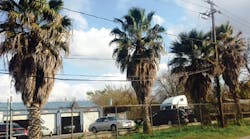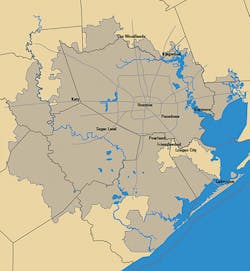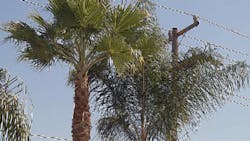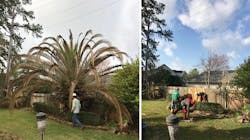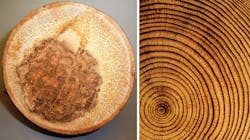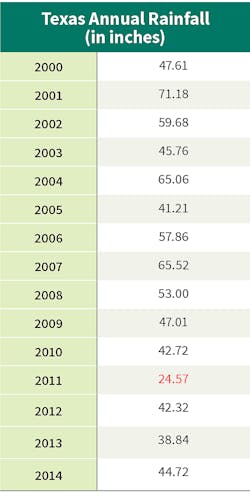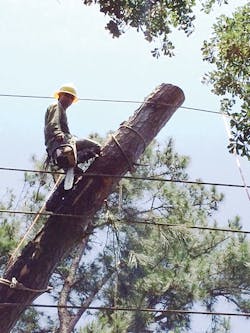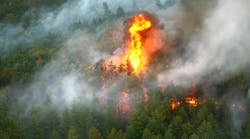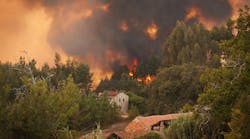Vegetation contacting power lines is the leading cause of power outages. Typically, 20% of reliability indices used by the utility industry are directly related to trees and another 5% are indirectly tree related through external influences such as wind and animals. Annually, CenterPoint Energy proactively addresses all types of vegetation on individual circuits selected through a cycle approach, with additional consideration for reliability performance and other business needs. The utility also proactively performs level-one tree-risk assessments along the main feeders of its system circuits with demonstrated increased exposure to hazard trees. At CenterPoint Energy, the greatest reliability threat from hazard trees is traced to palm and pine trees.
CenterPoint Energy’s electric transmission and distribution business serves more than 2.3 million customers in a 5,000-sq-mile area that includes Houston, Texas, the nation’s fourth-largest city. As a regulated utility, CenterPoint Energy ensures the safe and reliable delivery of electricity to homes and businesses on behalf of 69 retail electric providers. CenterPoint Energy does not generate power or sell it to customers. Assets include more than 51,000 miles of distribution lines, 3,700 miles of transmission lines, substations and a smart meter/intelligent grid infrastructure.
The utility currently employs 12 internal foresters, or utility arborists, to administer its vegetation management program. On average, more than 131 contract tree crews clear vegetation away from the utility’s distribution lines, trimming up to 1 million trees each year with a removal ratio between 12% and 15%. Because of Houston’s location, midway between the piney woods of eastern Texas and the lush, tropical atmosphere of the Rio Grande Valley, palm and pine trees flourish in the U.S. Department of Agriculture Hardiness Zone 9, presenting a unique threat to reliability.
Palm Trees
Palm trees cannot be trimmed to provide any reasonable length of service reliability, given their propensity to produce two sets of fronds per year. To mitigate the problems posed by palm trees, CenterPoint Energy’s practice is to remove, at ground level, palm trees located within utility easements and, as permitted, outside utility easements.
Botanically speaking, palm trees are more closely related to corn and turfgrass than trees. Palm trees are classified as a monocotyledon and have vascular bundles of phloem and xylem sheathed in strong, fibrous tissues and embedded in a matrix of parenchyma cells. Monocotyledons are characterized by having one seed leaf and fibrous stems. They lack a vascular cambium, have fibrous roots and parallel leaf veins, and have flower parts in ones and threes. Because of their aggressive growth habit and mature height, a number of palm species pose a service reliability threat and a fire hazard.
A typical tree (pine, oak or maple) is a dicotyledon, with two seed leaves, woody stems, a vascular cambium and a tap-root system. Veins in the leaves are net or web like, and the floral parts are in ones, fours and fives.
Most palm trees removed by CenterPoint Energy’s contract tree crews may have been planted as part of a professionally designed landscape plan. As one might suspect, these are valued specimens, and homeowners have great pride and satisfaction in their tropical backyard retreats. All is well when palm trees are young, but in 12 to 15 years, the trees may present public safety and reliability issues.
Despite their beauty, it may be necessary to remove palm trees interfering with utility infrastructure. Removing a healthy palm tree that accents a designed landscape requires both strong customer diplomacy and easement language. At CenterPoint Energy, a variety of utility easement configurations exist, inclusive of ground easements and aerial easements, to access and clear vegetation away from conductors. In situations with palm trees, when diplomacy fails to produce the needed clearance (that is, removal), a strong easement of adequate dimensions is highly beneficial. This enables the forester to resolve the conflict more promptly to ensure service reliability for all customers potentially affected.
Palm trees flourish in Houston’s subtropical climate, and they are desirable and attractive when planted away from power lines. Species of palm trees that can coexist safely with power lines include the pygmy date palm (Phoenix roebelenii), chusan palm (Ttrachycarpus fortunei), Mediterranean fan palm (Chamaerops humilis) and pindo palm (Butia capitata).
Pine Trees
Roughly 30% of the earth is covered in trees, with pine trees being the most widely dispersed species. Approximately 115 different species of pine trees exist in the world. The loblolly pine (Pinus taeda) is the most common species found in CenterPoint Energy’s service territory in southeast Texas. It is a native evergreen conifer that grows to 100 ft tall and up to 30 inches in diameter at maturity. The loblolly pine is a relatively weak-wooded, medium-lived tree with a tap root that tends to be longer (4 ft to 5 ft) in sandy or loamy soil than in clay soil. Houston has ample quantities of both soil types. Other species found in CenterPoint Energy’s service area include the shortleaf pine (Pinus echinata), longleaf pine (Pinus palustris) and slash pine (Pinus elliottii).
Like all plants, pine trees need the basic ingredients of sunlight, water and carbon dioxide to survive. Without these ingredients, photosynthesis cannot occur, and the pine tree will perish. With these three ingredients, the pine tree can convert sunlight to energy and make plant sugars, essential to the plant’s survival. Also important are the soluble nutrients absorbed from the soil by the roots of a growing tree.
Recently, one of the essential elements for the plant, namely water, was greatly reduced during the extended drought conditions from 2011 through 2014. This took a devastating toll on the pine plantations throughout Texas. The impacts and circumstances of the drought were significant:
- Roughly 305 million trees were lost in Texas during the extended drought conditions.
- Texas Forest Service estimates 2.1% of those trees were in the Houston area.
- As many as 1.6 million pine trees died statewide in 2012 alone because of the drought.
Hazard Tree Program
CenterPoint Energy’s hazard tree patrol program evolved from inspections initiated after Hurricane Ike made landfall in the Houston area in 2008. The major focus of the program is conducting routine periodic inspections of important distribution circuits and circuits thought to be at risk because of vegetation in the area. This proactive approach to mitigating the risks of hazard trees has proven to be beneficial and cost effective.
The value of the program was particularly evident when CenterPoint Energy was dealing with the significant damage that occurred during the 2011-2014 drought conditions. The timely inspections conducted as part of the program led to increased service reliability by addressing problem pine and hardwood trees before they caused damage.
The hazard tree patrol frequency varies based on circuit voltage, exposure and past reliability performance. Once the year’s inspection plan is established, each identified circuit’s backbone (or feeder) portion is patrolled for hazardous trees. The goal is to patrol all circuits within the piney woods area of CenterPoint Energy’s territory at least once a year. These and other circuits of increased concern may be inspected more frequently as warranted.
Before and particularly after the big drought, one of the most common hazards identified in CenterPoint Energy’s service area is a tall dead pine that could strike the utility’s facilities. Whether the tree is within an easement or not, CenterPoint Energy approaches the property owner to secure a signed permit to cut, drop and leave the hazard tree. Most people welcome someone cutting down their dead tree free of charge.
Line Safety and the Law
Whether the subject is palm trees or pine trees, another tree species or unrelated activities, there are important safety guidelines CenterPoint Energy stresses to the public and contractors working near power lines. Namely, all individuals are advised to keep themselves, coworkers, friends, family as well as any equipment and vehicles at least 10 ft away from residential electric lines and equipment. Further distances are required for higher voltages.
The following references are provided in safety literature routinely provided to customers and the public to reinforce CenterPoint Energy’s power line safety policy: “Federal Regulations, Title 29, Part 1919.180(i) and Part 1926.550(a)(15) and OSHA section 1910.333 require a minimum clearance of 10 ft from power lines. Information concerning digging near underground facilities can be found online referencing the Call Before You Dig 811 number.”
Managing Risk
Trees and other vegetation are the most frequent cause of electric outages and interruptions, but these risks can be managed with planning and strategic allocation of resources. CenterPoint Energy’s vegetation management program addresses the greatest of these tree hazards — the palm and pine trees — through inspection, permitting and removal.
In its journey toward world-class service, the CenterPoint Energy vegetation management group embraces the challenges that come through weather and other anomalies of nature. ♦
Gary O’Neil has worked in the utility arboriculture field for 35 years, holding job responsibilities from tree crew foreman to manager of vegetation management at various investor-owned utilities across the continental U.S. He holds a bachelor’s degree and a master’s degree in business. O’Neil is an International Society of Arboriculture certified arborist, ISA utility specialist, ISA test proctor and former chair of the Utility Arborist Association’s education committee.
Tim Yurick, a native of Houston, Texas, attended Stephen F. Austin State University in the heart of the piney woods. He is an International Society of Arboriculture certified arborist and has been in the utility forestry industry as a forester for five years, with the bulk of that time spent in Houston.
